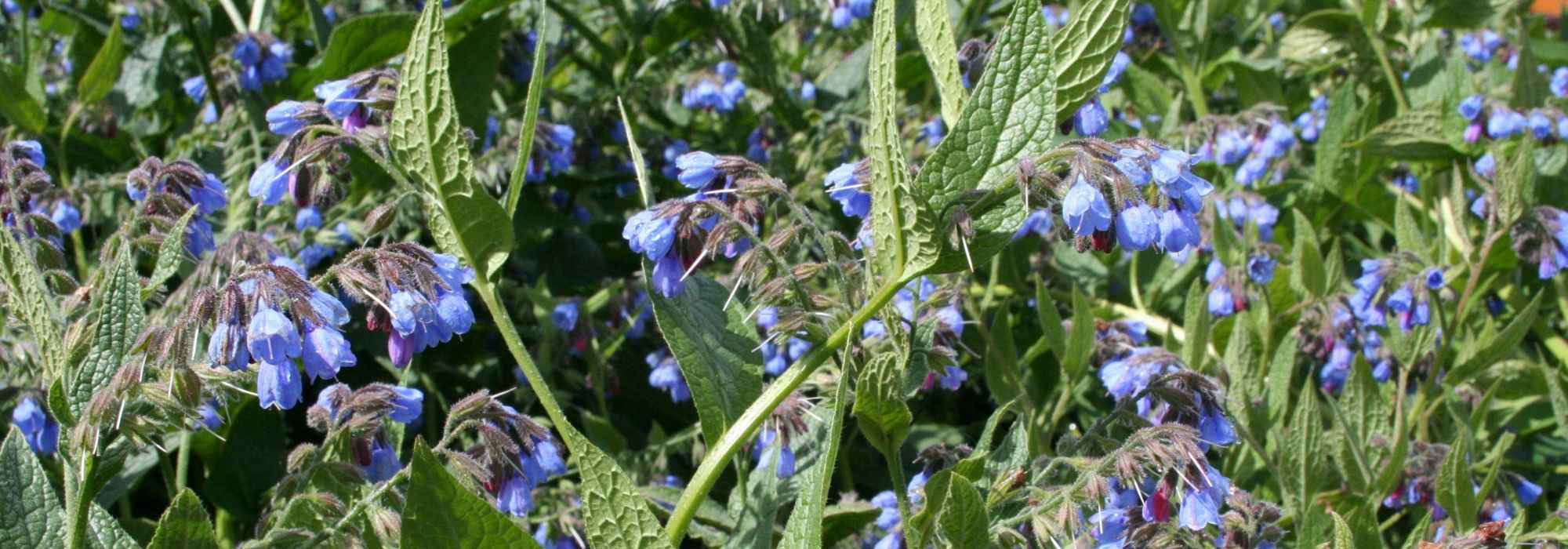
Comfrey: planting, sowing, uses
Contents
Comfrey in a nutshell
- Comfrey is the ultimate groundcover, perfect for forming large colonies in the understorey, between bushes, where nothing else will grow!
- In spring, it produces small clusters of white, pink or purplish flowers that continue through to summer
- Comfrey or Symphytum officinale has been known since Antiquity for its medicinal properties in ointments and balms
- Its edible leaves are used in cooking and in the garden as a fertiliser and comfrey manure
- Comfrey suits all cool spots: decorative and easy to grow, ideal for shaded or damp areas in a natural garden
A word from our expert
Comfrey is a perennial plant with countless virtues! Known since antiquity for medicinal properties, Symphytum officinale, common comfrey remains widely used in homeopathy, in ointments or balms, notably to help treat conditions such as tendinitis. Comfrey is used in many ways: as a culinary plant in the vegetable garden, where its edible leaves, rich in vitamin B12, can be added raw or cooked to numerous recipes, but above all in garden or permaculture as fertiliser and natural manure rich in potash, trace elements and vitamins!
But comfrey is also a decorative plant! It not only has a melliferous spring flowering ranging from pink, purple, white to sky blue, but its large leaves add striking texture to garden and shaded areas and, thanks to seeds easily dispersed, it self-seeds very readily. Comfrey is ultimate groundcover, it prospers wherever we want soil to be covered without any maintenance!
From Tuberous Comfrey (Symphytum tuberosum) to highly ornamental Russian Comfrey (Symphytum x uplandicum), all are easy to grow and deserve a little space in our gardens.
Endowed with natural propensity to form vast colonies in most inhospitable areas of garden, comfrey is ideal for shady or damp areas, in a garden that makes room for nature.
Discover how to grow, plant or sow it, combine it in the garden or how to make a comfrey manure!
Choose from our unique collection of perennials for shade!
Description and botany
Botanical data
- Latin name Symphytum
- Family Boraginaceae
- Common name Comfrey
- Flowering March to August
- Height 0.15 to 1.50 m
- Sun exposure Sun, partial shade, shade
- Soil type Clayey, fresh
- Hardiness -15°C and beyond
Symphytum, better known as comfrey, is a herbaceous perennial of the family Boraginaceae, like its relatives borage, lungwort and forget‑me‑not. It grows wild in damp meadows, on riverbanks and at woodland edges across Europe and Asia, as far as eastern Siberia.
The genus includes about 35 perennial species and numerous hybridizations. Symphytum officinale, common comfrey or greater comfrey, Symphytum grandiflorum or large‑flowered comfrey, Symphytum azureum with blue flowers, Symphytum rubrum, red comfrey, and Symphytum caucasicum or Caucasian comfrey are among the Symphytum most commonly found in gardens. Large‑flowered comfrey has produced several graceful bicoloured‑flowered cultivars. Russian comfrey (Symphytum × uplandicum) is a highly ornamental hybrid variety.
A groundcover with a suckering rootstock, Symphytum forms mats quickly reaching 0.15 to 1.20 m in height, or much more where soil and position suit it, and up to 1.5 m in spread. Comfrey spreads laterally by its fleshy, brittle rhizome and forms large, vigorous colonies, in woodland understory, on slopes, in short wherever few plants will grow. The plant has a vigorous root system: its roots penetrate deeply into the soil.
From this bushy clump emerge erect, square stems, very close together and branched in their upper parts. Completely covered in hairs, they carry a rough, villous deciduous to semi‑evergreen foliage, reminiscent of nettle. Leaves are leathery, alternate, ovate to lanceolate with a wrinkled aspect and prominent veins. They reach 20 to 80 cm in length and are so hairy they have earned comfrey the nicknames “donkey’s ears” or “cow’s tongue”. Young leaves of Symphytum officinale can be eaten raw or cooked. Foliage ranges from mid to light green and is sometimes marginate with yellow (comfrey ‘Goldsmith’).
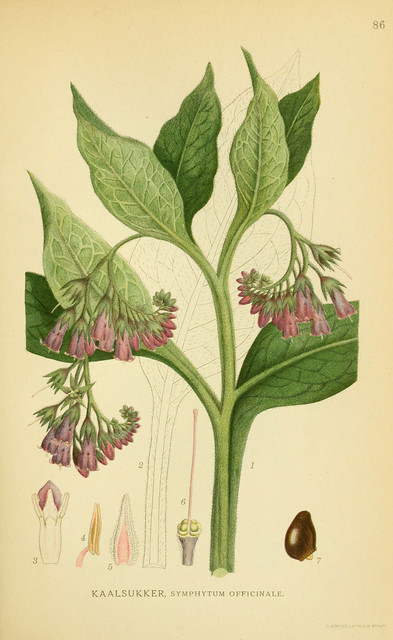
Symphytum officinale – botanical illustration
Comfrey’s flowering is charming. On this dense, pubescent foliage, small little bells appear from March to August depending on species and climate. Tubular, pendulous flowers 1 to 3 cm long are grouped in cyme clusters shaped like a crozier at stem tips. It is Symphytum grandiflorum that displays the largest flowers! Their corolla is campanulate, formed of short recurved lobes inserted in a tubular calyx with tapering sepals.
These little bells come in different colours, generally white, pink or purplish, sometimes blue in Symphytum azureum or pink‑crimson in red comfrey. Cultivars of Symphytum grandiflorum show more contrasted, infinitely delicate hues; white with blue calyx, pale pink with red tip or varying between pink, blue and white (Symphytum ‘Goldsmith’).
Filled with nectar, these flowers attract pollinating insects, notably bees; once pollinated they transform into achene fruits containing seeds that self‑sow very easily in gardens.
Comfrey is among the least demanding plants, able to grow in the most ungrateful corners of a garden and to form large groundcovers under trees or among bushes. Hardy and very accommodating, it nonetheless prefers fresh, humus‑bearing soils and shaded or damp areas, even clayey ones. It will grow without gardener’s help in partial shade as well as in shade, but will also tolerate sun that is not too strong provided the soil remains cool and moist.
This robust perennial can establish itself in a mixed border, in woodland and on the edges of water features. With its simple, charming flowering and bushy silhouette, it naturally finds its place in the ornamental garden, in country‑style beds and in natural or wild gardens.
It is much appreciated in organic gardens and in a vegetable garden under permaculture, firstly for its strong nectariferous potential and because it makes an excellent manure once transformed into comfrey manure, ideal for growing flowers and fruit and a good activator of compost rich in nitrogen and potassium. It is also reputed as an insecticidal and natural repellent. Thanks to its vigorous roots, it helps break up the heaviest soils, a useful trait in crop rotation. It is also commonly grown as a forage plant.

A few comfrey flowers: Symphytum azureum, Symphytum grandiflorum and Symphytum officinale var. patens
Known since antiquity for its medicinal qualities, comfrey owes its vernacular name to its abilities to consolidate fractures and to heal wounds when applied as a lotion or as a poultice of leaves.
Edible, young leaves of common comfrey can be eaten raw in salads or cooked like spinach when picked later and enjoyed in soups or purées: flavour varies from one comfrey to another. Young flower buds have a slight iodine taste and are eaten cooked.
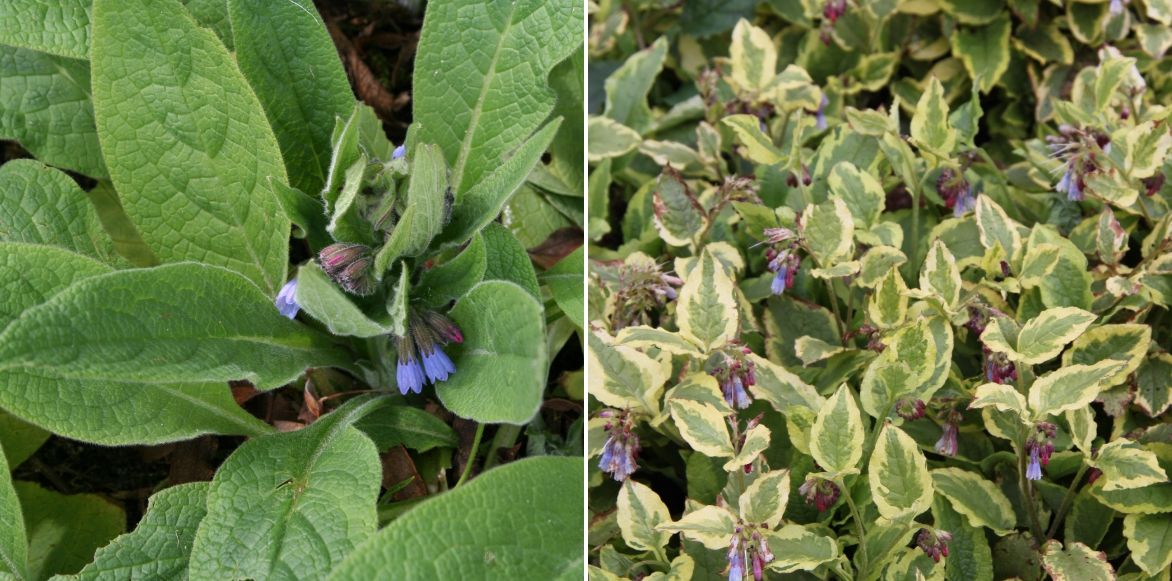
Foliage of comfreys: green for the classic forms and variegated for the variety ‘Goldsmith’
Read also
What to plant under a tree?Main species and varieties
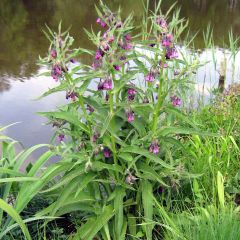
Symphytum officinale - Comfrey
- Flowering time May to July
- Height at maturity 80 cm
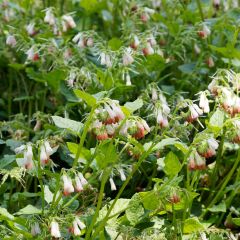
Symphytum grandiflorum - Comfrey
- Flowering time June, July
- Height at maturity 30 cm
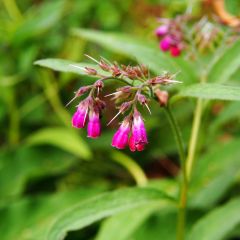
Symphytum rubrum - Red Comfrey
- Flowering time May to July
- Height at maturity 40 cm

Symphytum Goldsmith - Comfrey
- Flowering time June, July
- Height at maturity 30 cm

Symphytum Hidcote Blue - Comfrey
- Flowering time June, July
- Height at maturity 35 cm
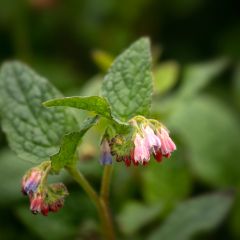
Symphytum Hidcote Pink - Comfrey
- Flowering time June, July
- Height at maturity 35 cm

Symphytum azureum
- Flowering time May to July
- Height at maturity 30 cm
Discover other Symphytum - Comfrey
View all →Available in 0 sizes
Available in 1 sizes
Available in 2 sizes
Available in 2 sizes
Available in 1 sizes
Available in 1 sizes
Available in 1 sizes
Available in 2 sizes
Available in 1 sizes
Available in 1 sizes
Sowing and planting
Where to plant and sow comfrey?
Hardy beyond -15°C (sometimes to -30°C), comfrey establishes easily in all gardens, although it may be more difficult in Mediterranean regions as it does not tolerate arid conditions.
It occurs naturally in moist environments and particularly thrives in cool, rich, humus-bearing soil. Extremely accommodating, this vigorous perennial will also grow in poorer soils, including calcareous or clay soils. It likes non-scorching sun and will prefer an aspect shaded by large trees in our warmest regions.
Given its very deep rooting and vigorous growth, give it a generous spot where it can flourish over the years, as it thrives forming attractive groundcover where nothing else grows!
Tolerating occasional foot traffic, comfrey is a good alternative to lawn that allows few adventive plants through: an ideal solution for neglected areas of the garden in the understorey, under trees, anywhere most other plants refuse to grow and where soil is to be occupied without maintenance.
Comfrey naturally finds a place in natural or wild gardens, in a large cool mixed border, to edge a shaded path, to flower at the base of trees and bushes on the woodland edge, in a shady rockery, as well as in an organic vegetable garden where its flowers attract many bees and pollinators while repelling aphids! It will also add height and lightness to naturalistic meadows.
When and how to plant comfrey
Comfrey bought in buckets is planted equally in spring from February to April or in autumn from September to November, outside frost periods.
In open ground
Plant your comfrey young plants 0.5 to 0.7 m apart, bearing in mind the plant fills out year after year. Soil must be well worked in depth and enriched with well-rotted compost.
- Loosen soil well
- Dig a hole 2 to 3 times volume of bucket
- Add gravel to bottom of planting hole
- Backfill with garden soil mixed with compost
- Water generously, especially during first summer
- Mulch soil after planting
→ Learn more in How to successfully grow comfrey?
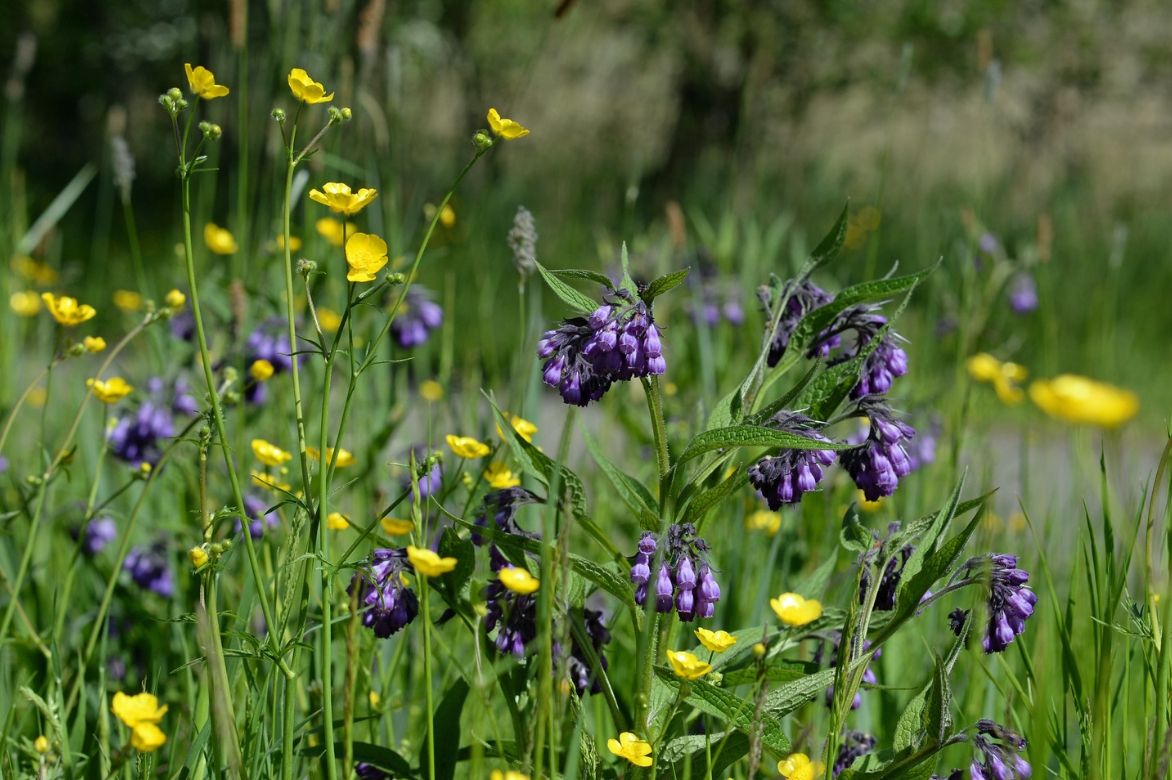
Symphytum officinale and Ranunculus sp.
Read also
12 perennials for heavy, wet soilWhen and how to sow comfrey?
Sow comfrey ideally from March to June under cover or by direct sowing.
Under cover
- From February–March, sow seeds in small groups of 4 or 5 seeds, spaced about 40 cm apart at a depth of 1 cm, in buckets filled with good seed compost
- Cover seeds lightly with a fine layer of soil
- Keep moist during germination
- Prick out into garden when seedlings have 5 to 6 leaves, keeping spacing of 50 cm between each plant
In open ground
Comfrey seeds are sown directly in place, after last frosts around May in moist, rich and well-drained soil.
- After drawing furrows 1 cm deep, sow 4 to 5 seeds in small groups, into little holes 1 or 2 cm deep spaced about 30 cm apart
- Cover with a fine layer of soil
- Firm down with the back of a rake
- Keep soil moist but not waterlogged during germination
- Thin out, keeping only the most vigorous plants every 50 cm
- Water regularly to aid establishment
Follow our advice to succeed in sowing perennial plants!
Harvest and use of comfrey
Comfrey, Symphytum officinale, also called great comfrey, is a plant with many virtues, known since antiquity. Great comfrey is commonly cultivated in gardens for its medicinal properties, for its edible leaves, but also as a fertiliser, manure or repellent.
Leaves rich in protein, potassium and vitamin B12 are harvested from May to October as required and have a slight sea-like flavour.
In cooking, young leaves can be enjoyed raw and added to salads or cooked, stuffed or prepared in soup or purée. Flower buds can be cooked like broccoli. Stems and midribs of large leaves can also be cooked like cardoons or Swiss chard.
However, be careful: comfrey is among plants to be consumed in moderation as it contains substances toxic to the liver if eaten daily and over long periods.
Comfrey leaves keep very well once dried.
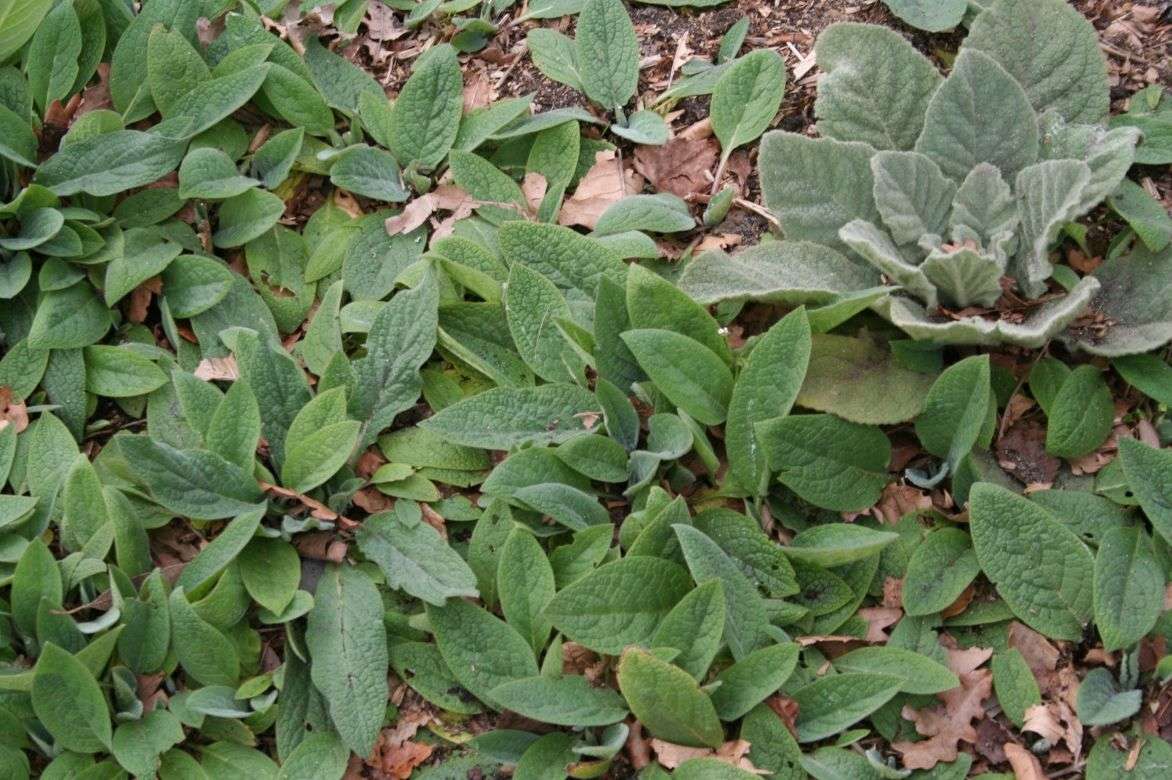
Young comfrey leaves
How to make comfrey manure?
Comfrey manure, very rich in potash and boron, is a growth stimulant: it is an excellent green manure that will stimulate flowering and fruiting and will act as an activator in compost, allowing organic waste to decompose more quickly. Discover our recipe to make your comfrey manure or fermented extract and its uses in the garden and vegetable patch on our fact sheet!
It can also be used as:
- Decoction: dilute comfrey manure to 5%, it will make an effective natural insecticidal treatment against aphids.
- Fertiliser: dilute to 10%, it makes an excellent natural fertiliser and will provide nutrients needed by garden flowers and vegetables.
- Comfrey mulch: comfrey makes excellent mulch, it is very useful in permaculture: roughly chop comfrey leaves and make a bed around base of vegetables; as they decompose they will provide nutrients to soil.
Care and maintenance
Hardy and vigorous, Comfrey requires minimal maintenance once established in cool to moist soil. Water during first two summers, especially in hot spells so it establishes properly. Afterwards, it even tolerates brief summer drought.
Mulch in autumn with a generous layer of compost to fertilise. Comfrey forms a dense groundcover that requires no weeding.
To avoid being overrun, remove undesirable spontaneous sowings as soon as possible because great comfrey, once established, is difficult to eradicate.
Diseases and potential pests
Comfrey shows very good disease resistance. In hot, dry weather it can sometimes be affected by infestations of flea beetles, small beetles that chew small holes in the foliage. As a preventative measure, mulch the base of the plant to retain adequate moisture, as these little pests hate damp, and water daily to curb their attacks. In case of infestation, spray with nettle or tansy manure.
Multiplication
If Comfrey self-seeds fairly freely (find our tips for successful sowing in the “How to sow comfrey” section), it is also easy to propagate, by stump division in October. Carry out once plant is well rooted, after at least 2 or 3 years’ cultivation.
Division
- Lift clump with garden fork
- With spade, cut a few divisions
- Replant immediately in garden in humus-bearing, cool soil
Root cuttings
Comfrey root cuttings are also easy. With a spade, simply collect root sections from about 10 cm deep. Replant immediately at desired spot.
Companion planting with comfrey in the garden
Comfrey, in addition to its environmental and medicinal qualities, offers great ornamental interest. Attractively bushy, flowering from spring to summer, it naturally finds its place in natural and wild gardens, fits into meadowy beds of a cottage garden, shady rockeries, woodland edges and naturalistic meadows. It is ideal in a shade garden or under trees, where few plants will grow.
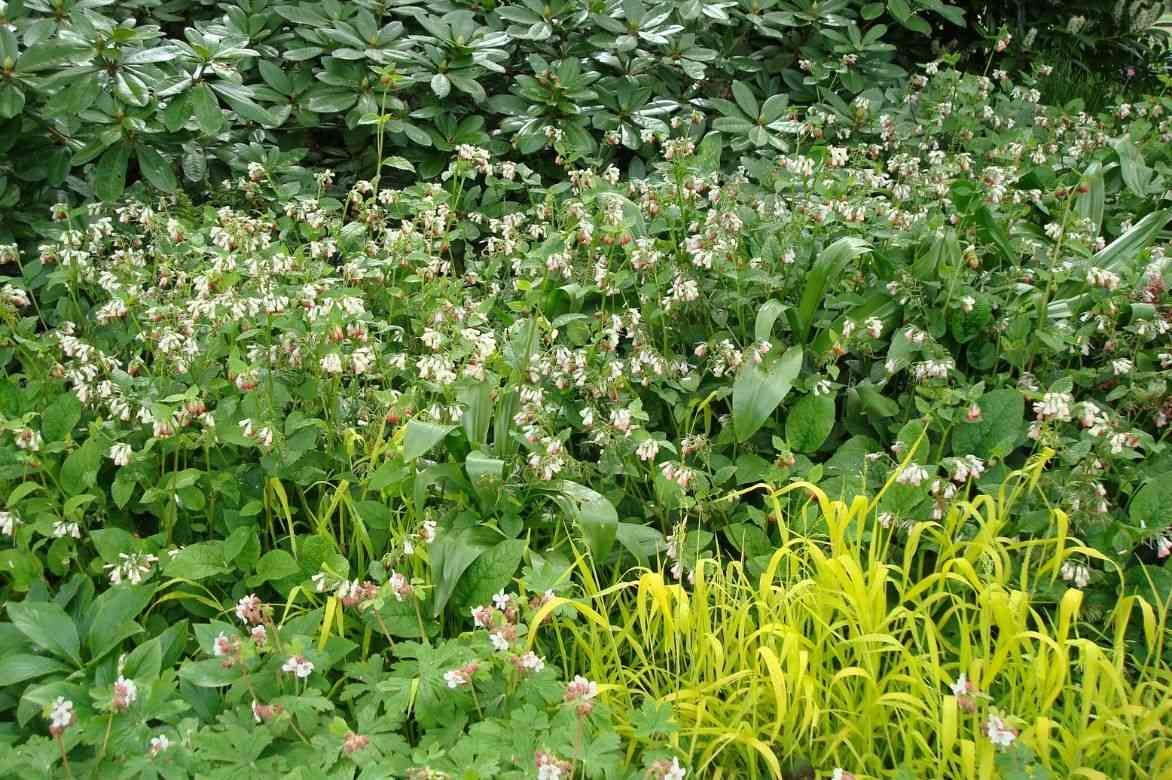
An example of a planting combination in a shaded area: comfrey accompanied by Milium effusum ‘Aureum’, Geranium macrorrhizum ‘Spessart’, Hellebores and rhododendrons in the background
Pair it with wild-looking plants and shade perennials such as Melittis, Acanthus, goat’s beard, galanes or knotweeds.
It is a shade- and moisture-loving plant, ideal near water features, alongside ferns, grasses, Rodgersia and astilbes, or on edges of damp woodland with Tiarella.
Plant en masse to cover ground of a shady path or to flower woodland areas highlighted by a tapetum of golden Sagina, candelabra primroses and the blue flowers of Corydalis and hepatica.
Comfrey is a trouble-free ground cover, to plant under trees and deciduous bushes, to bring colour to woodland with Brunnera macrophylla, Asarum, colourful foliage of Heuchera and Heucherella and creeping bugles.
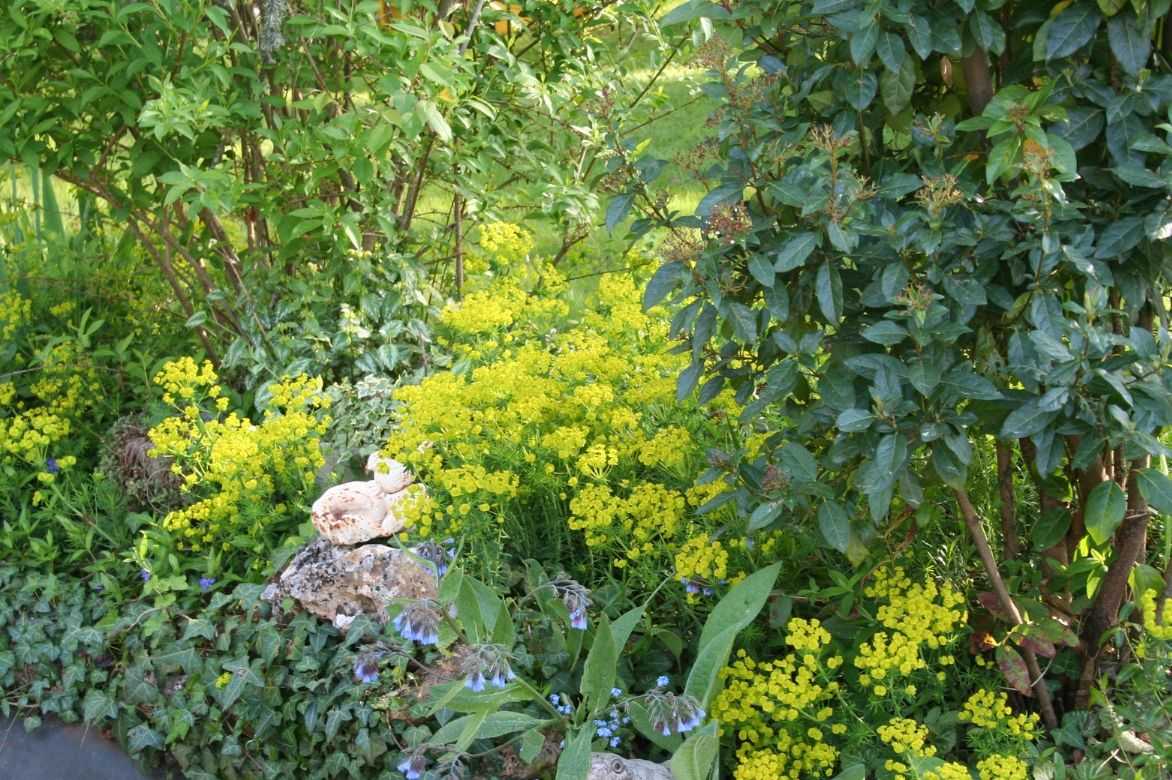
An example of a ground-cover association with Euphorbia ‘Petit-Cyprès’ and ivy
It is also a fine plant for a romantic border, working wonders at the feet of shrub roses and hydrangeas among mid-shade perennials; alongside the large leaves of Hostas, bleeding heart, pulmonarias, hardy geraniums, foxgloves, Epimedium, Lamium, columbines, for example. It is also ideal in association with shrubs such as rhododendrons and weigelas.
In romantic spring scenes, it pairs well with spring-flowering bulbs, notably pink or purple tulips.
Placed on the edge of a vegetable garden, alongside borage and lemon balm, it contributes to better pollination by attracting bumblebees and bees.
Discover our planting ideas with our advice sheet “What to plant under trees?”
Useful resources
- Discover our different varieties of comfrey.
- selection of 15 medicinal plants with many benefits… to grow in your garden
- Subscribe!
- Contents
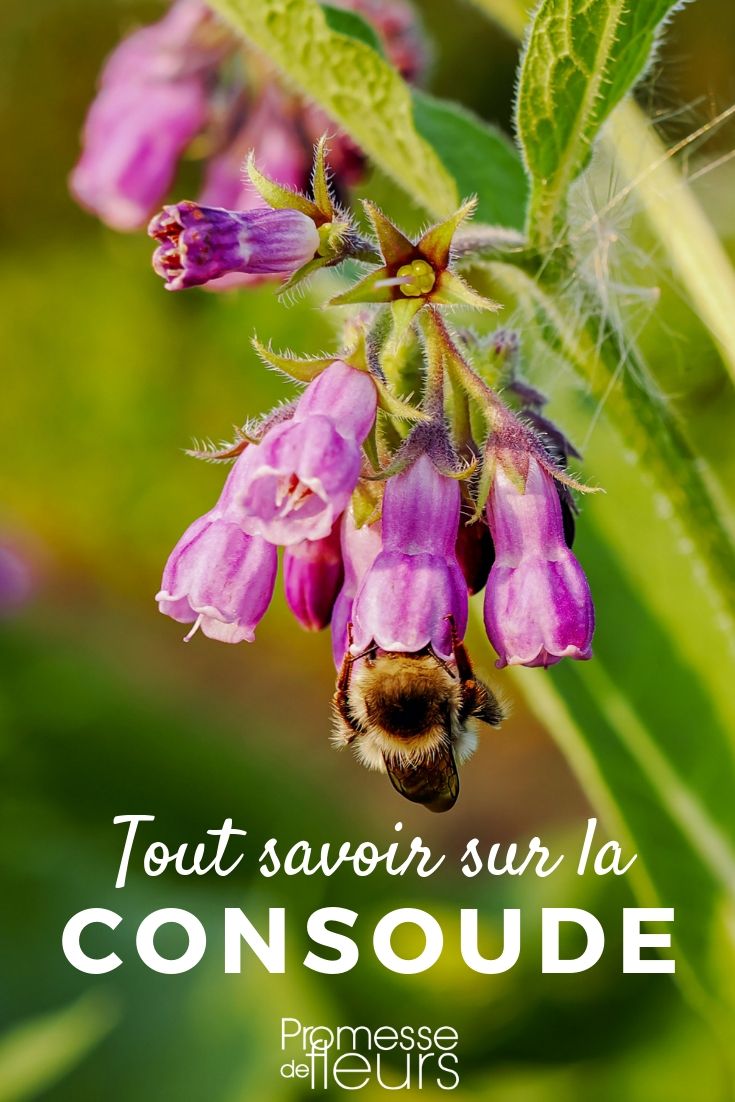































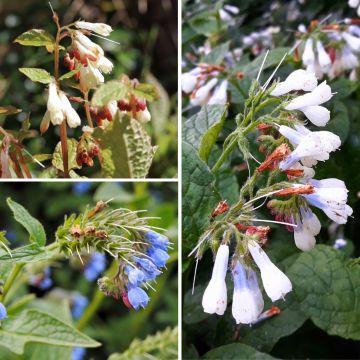
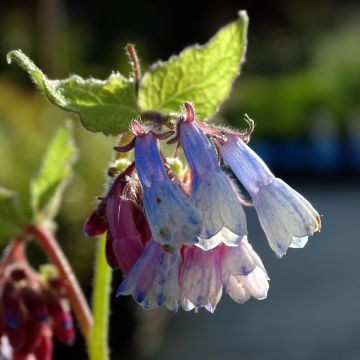

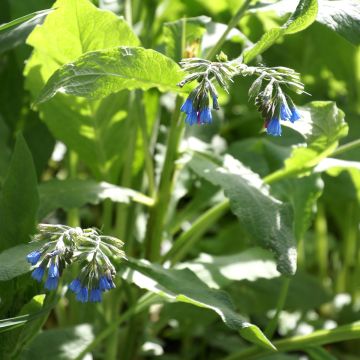
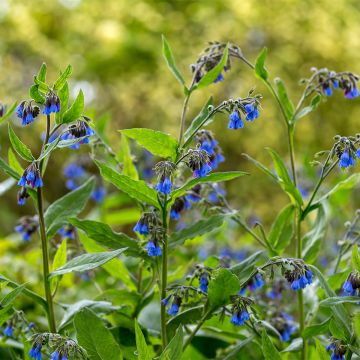

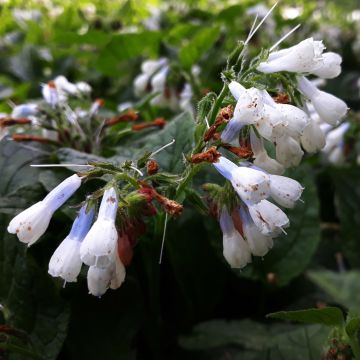

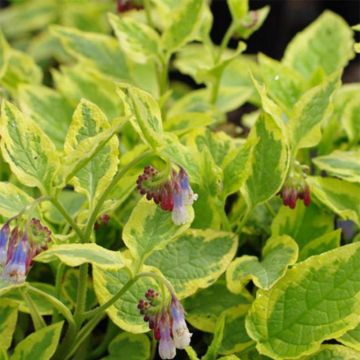

Comments